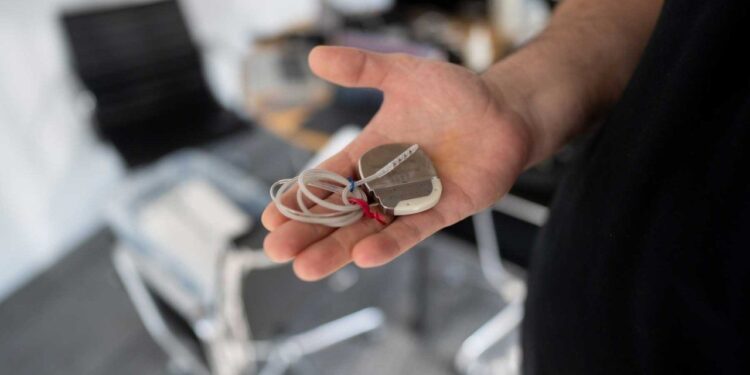Nearly a quarter of Americans live with chronic pain, or pain that drags on for at least three months. For many, their pain is resistant to any treatment.
In 1972, UCSF Neurological Surgery Professors John E. Adams, MD, and Yoshio Hosobuchi, MD, became the first in the U.S. to test continuous deep brain stimulation for chronic pain. Successive international teams attempted deep brain stimulation experiments for persistent pain for more than 50 years. Each team reproduced Adams’ and Hosobuchi’s fleeting results.
But scientists came to suspect that, over time, the brain got used to the “always on” current and, eventually, learned to outsmart it. Pain returned.
In 2023, Prasad Shirvalkar, MD, PhD, an associate professor of anesthesiology and neurological surgery, became the first to discover individual pain biomarkers, biological signals that can be detected and measured, by matching brain activity gathered via implanted electrodes with patient pain logs. He used artificial intelligence to predict when patients would be in pain based on their brain signals.
The discovery enabled clinical trials at UCSF of personalized deep brain stimulation systems that can sense when pain markers arise and then deliver targeted stimulation on demand — like a thermostat kicking in to cool a room that has gotten too warm. These initial studies could pave the way for larger trials, bringing this technology from lab to home.
Depression
Sarah’s depression was so bad when she met UCSF’s Edward Chang, MD, that she couldn’t see a way out.
“I was at the end of the line. I was severely depressed. I could not see myself continuing … if I could never move beyond this,” she told UCSF in 2021. “It was not a life worth living.”
Nearly 1 in 3 people diagnosed with major depressive disorder in the U.S. live with treatment-resistant depression like Sarah.
Sarah, a clinical trial participant whose depression symptoms were alleviated by electrical currents from a deep brain stimulation device. Image: Maurice Ramirez
By 2018, Chang and colleagues had utilized advanced brain mapping techniques developed at UCSF to identify patterns of electrical brain activity that correlate with mood states and discover new brain regions that could be stimulated to alleviate someone’s depressed mood. In 2020, Chang’s team used this knowledge to provide Sarah with a personalized deep brain stimulation system that finally lifted her depression. Her success shows that personalized deep brain stimulation might, one day, be an effective treatment for others.
“In the early few months, the lessening of the depression was so abrupt, and I wasn’t sure if it would last,” she remembered. “But it has lasted. And I’ve come to realize that the device really augments the therapy and self-care I’ve learned while being a patient here at UCSF.”
The two approaches, deep brain stimulation and talk therapy, have helped bring her intrusive thoughts under control: “Those thoughts still come up, but it’s just … poof … the cycle stops.”
Today, UCSF Psychiatry Professor Andrew D. Krystal, MD, PhD runs a federally-funded trial studying deep brain stimulation and depression that, if successful, could help take the technology that saved Sarah’s life to millions more.
See how deep brain stimulation devices can detect brain activity associated with depression and trigger stimulation in response. Sarah’s device drastically improved her quality of life.
Obsessive-compulsive disorder and beyond
Today, NIH funding through the BRAIN Initiative and other programs has enabled UCSF to become one of only about a dozen hospitals that offer continuous deep brain stimulation as part of psychiatric care for intractable obsessive-compulsive disorder (OCD). OCD is marked by uncontrollable, recurring thoughts and repetitive, hard-to-resist behaviors, and it affects about 1 in 50 Americans. Currently, the Food and Drug Administration limits deep brain stimulation to only the most severe cases.
Andrew Moses Lee, MD, PhD, directs UCSF’s OCD Program. Lee is currently leading a small clinical trial to identify potential biomarkers of OCD symptoms in the brain and possible sites for personalized deep brain stimulation in the future. Together with Krystal, Lee is also leading a clinical trial to evaluate personalized deep brain stimulation for the condition.
Chang believes such treatments could help treat conditions like addiction, Tourette syndrome, and even Alzheimer’s disease, though each condition would have its own type of signature.
“Tailoring these treatments to the person’s neural signature is really the key that allows DBS to be effective across many conditions,” he said.
Copyright for syndicated content belongs to the linked Source link





